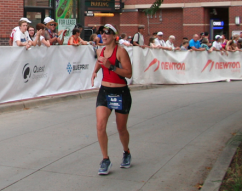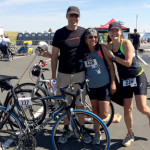We all want to run “better”, but what does that really mean? It will mean different things to different runners and triathletes. In part one of this series, I covered 7 key positions of good running form. In order to continue to progress your running, you must work to stay healthy. If you’re injured or sick, your fitness, strength, endurance and speed will suffer.
Here are 7 key points of running healthy:
- Prevent injury. It goes without saying, being injured and unable to run will not help you run better! To run better, you need a positive rate of adaptation to training stresses, i.e. continue to progress your fitness over time. Prevention is the best way to stay injury free. The next 6 tips will help you accomplish this goal. (See my blog post on injury prevention for more details.)
- Balance running stresses through the training period. In order to both run healthy and run better, you need to balance your running stresses: volume, volume of intensity and running pace. Rate of adaptation to run training will vary from athlete to athlete, i.e. the factor of individual variation. Some can handle back to back hard running days, some can only run hard every 4th A good coach can help you balance these stresses to reach your optimal goal and stay healthy. Don’t get stuck running at the same pace, this will ultimately lead to a plateau you’ll need to bust through.
- Develop elasticity and stability during your strength and flexibility routine. Many running injuries are a result of repetitive use and excess ground contact time. A good strength training routine, completed year round, will help (more on this subject in part 3). It’s important to improve elasticity (your fast twitch muscle system) in your lower leg (gastroc & soleus), hamstrings, and hip flexors, to help prevent excess ground contact time. This elasticity will allow your foot and leg to “pop” up off the ground quicker. Hip stability is also critical so that when your foot lands, your hip and knee don’t collapse on. You need to be able to land on one leg repeatedly without dropping your hip.
- Develop a pre-run and post-run routine. Establishing a healthy routine, helps us develop and maintain healthy habits. Completing a dynamic warm up pre-run will get your fast twitch muscle system working. This is important for both increased elasticity and stability. Include exercises that fire up the muscles in your feet, ankles, lower and upper thighs, hips, abs and shoulders. Progress the exercises from simple to complex and slower to faster motions. Your run will feel better (and most likely be faster) and you will recover faster. A good dynamic warm up requires only about 10 minutes to be effective. Your cool down and post run routine should focus on cooling and turning off your muscles to improve your recovery.
- Change up your running surface. Not all surfaces are created equal, the harder the surface, the more impact stress on your body. Concrete is the hardest on your body, followed by asphalt. Most often we race on these surfaces, so it is important to spend a percentage of your training time on them. Running on dirt is much easier on your joints and allows your body to recover faster. A treadmill can offer more cushion as well, especially a Woodway. (Look for one at your gym!)
- Optimize recovery. A good warm up and cool down help you recover faster. Post run is when you want to do your static stretches (long hold stretching) as this turns off the muscles so they can recover faster. Good nutrition, hydration and sleep, especially sleep! will speed recovery. Foam roller, massage, Normatec, etc are also good tools to use. Have you ever visited a dedicated recovery center?
- Prevent illness-don’t get sick! Nobody likes to be sick and it can be tough to avoid at your office or from your kids. It’s ok to train if your illness is minor, but decrease the overall volume, intensity and frequency until you’re back to 100%. (see my blog post on preventing illness).
Good running form, plus injury prevention will help you progress your running from month to month and year to year. Next up, part: Running strong: what does that mean?


